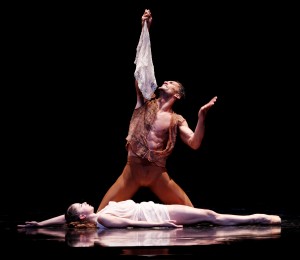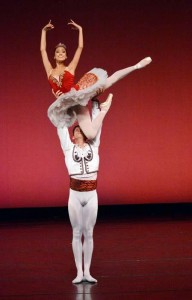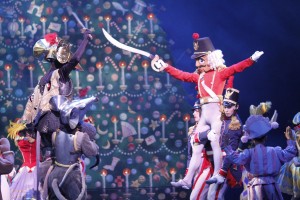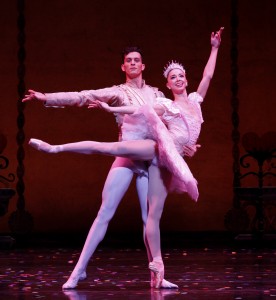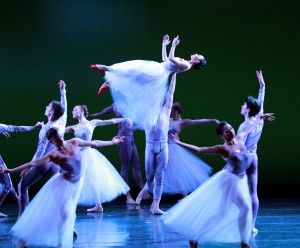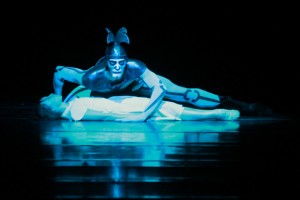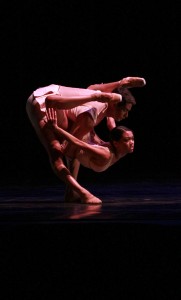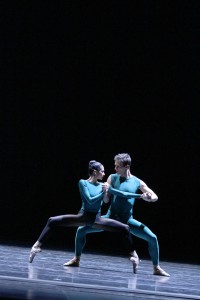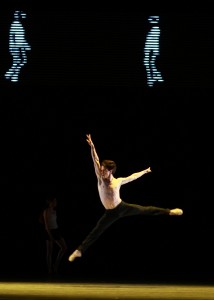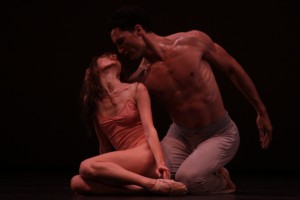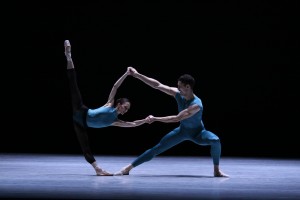At 6’6″ and 216 lbs, this 32-year-old Joffrey Ballet dancer stands out on stage…or anywhere. In 2009, landing the lead role in Lar Lubovitch’s Othello solidified him as a star. “It’s the ultimate role,” said Fabrice Calmels*. This week he revises this life-changing role as Joffrey presents the three-act ballet for a two-week run at the Auditorium Theatre before it is retired from the active repertory.
Calmels grew up outside Paris, France and began dancing at age three at a small school in Magnanville. By 10, he was studying at the Paris Opera Ballet School and by 16 things really began to change. “I became very tall and it became an issue,” he told me over tea last week. “They told me I wouldn’t do very well in the company, that I wouldn’t be dancing very much.” He came to the States to study and dance at The Rock School in Philadelphia, then traveled across the country auditioning. After a year dancing with Boston Ballet II, he accepted a spot with Joffrey in 2002. He’s now finishing his 11th season here in Chicago.
Being plagued with a back injury (two bulging discs) for almost a year hasn’t slowed him down much. He’s hard at work preparing for the Othello run, bulking up and building stamina. Calmels spoke with RB about dancing this signature role.
You’re almost a week before opening. What was your schedule like today?
We’ve been very meticulously working on the first act now for a few weeks trying to really get all the dancers to understand Lar Lubovitch’s style. Lar has a very specific style that’s very circular and grounded. When you’re dealing with younger dancers who’ve been training in mostly ballet, they’re up, up, up and he wants down, down, down. To get his style ingrained in your brain and to really feel confident takes a while. When you understand, it becomes easier. The second act came together really quick. Now we’re working on the third act. Today we ran the first and second act…not right away. We ran one, then had notes and then the second act and notes. I think tomorrow we’ll run all three acts and start getting momentum, because we need it.
This role made you a big star here. What are you doing to take it to the next level?
I follow different training. I want my body to be very strong and tense. I need that frame to be really solid, so I don’t hurt myself. I needed to gain weight. In a long run, you tend to lose weight because you’re so tired and overburning. I bulk up to become the character, one, and so I have the structure that I can handle the ballet. I’m working out a lot more. I’m working out my legs more. I run more. I do like ten miles every other day to build stamina in my legs. The last production my upper body was strong, but by the middle of the third act, my legs were burning. In terms of character, I want to completely submerge myself in the character and be able to be the character through the three acts. My goal this time is to stay in character, even though there’s intermissions, and see where it leads to. I want to be able to produce that all the way through. The character and the role is as important as the dancing. Otherwise, you lose the audience very quickly. They want to hear the story, they want to care, they want to hate you, the want to feel emotion. What will make a huge difference is what reads. It’s not a battement. It’s the emotion and the acting.
What does dancing the role of Othello mean to you?
The role Othello is really magic. It’s magic. I saw “Othello” when I was younger. Desmond (Richardson)…he’s a legend. There aren’t many that have done the role. To be asked to do it, at first it was a lot of weight. It’s huge. I feel really fulfilled. Thank you Lar. He’s a master to create such a piece. It’s a difficult role physically. It’s tense. It’s a marathon. You have to be powerful all the way to the end.
You’re dancing with April Daly again. Do you find you’ve evolve as partners in these roles?
Of course. There’s the experience. The second shot. It’s the big problem in ballet, you get that one first shot. Now we can look back and see that we were able to do it, but the first time, it was a challenge for us. They were big roles for us. I think we were taking it a little bit too tense even though it was a good run. It was a huge risk for the Joffrey and it was a big deal. The second time around, we know we can deliver. We know what to do. We know how people reacted the first time, so we can do better. It can only go up. She knows she can trust me.
Are you nervous? Do you get nervous?
I’m a perfectionist. When I do well, I expect to do better. When I don’t get this, sometimes it really pisses me off. I want consistency. I hate roller coaster seasons. I hate roller coaster performances. I think they are the worst. I want to deliver great and above. That’s my only concern. It’s myself. I want to have always great, better, better.
Joffrey Ballet presents Lar Lubovitch’s Othello at the Auditorium Theatre, 50 E. Congress Pkwy. Wednesday, April 24 – Sunday, May 5. Tickets are $31-$152. Call 800.982.2787 or visit joffrey.org/othello.
*Calmels performance schedule:
Wednesday, April 24 at 7:30 pm
Friday, April 26 at 7:30 pm
Saturday, April 27 at 7:30 pm
Saturday, May 4 at 2 pm
Sunday, May 5 at 2 pm

